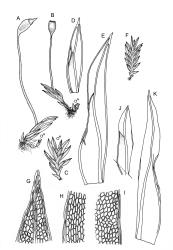- ≡ Fissidens inclinabilis Müll.Hal. ex Dixon, Bull. New Zealand Inst. 3: 100 (1923)
- ≡ Fissidens pungens var. inclinabilis (Dixon) Sainsbury, Rev. Bryol. Lichénol., n.s. 21: 214 (1952)
- = Fissidens subelamellosus Dixon, Bull. New Zealand Inst. 3: 364 (1929)
Leaf borders comprising several rows of prosenchymatous cells on vaginant laminae, poorly defined and incomplete or absent on dorsal and apical laminae. Setae 4–15 mm; capsules inclined to horizontal, arcuate.
Dixon 1923, pl. 7, fig. 2 (as F. inclinabilis); Dixon 1929, pl. 10, fig. 15 (as F. subelamellosus); Beever et al. 2002, p. 26, figs 1–4; Stone & Catcheside 2012.
Fissidens curvatus var. inclinabilis may be vegetatively indistinguishable from varieties of F. taylorii, but differs from the latter in the strongly asymmetric capsule, and peristome teeth with deep adaxial trabeculae ornamented with fringed margins in their supra-basal region.
NI: N Auckland, S Auckland, Hawke’s Bay, Wellington; SI: Nelson, Marlborough, Canterbury, Otago, Southland.
Australasian. Mainland Australia*.
Usually on mineral soil, but one specimen (type material of F. subelamellosus,) is labelled "on stump". Associated mosses include species of Bryum, Ceratodon purpureus, Eurhynchium praelongum, F. curvatus var. curvatus, F. taxifolius, F. taylorii var. sainsburyanus, and Thuidiopsis furfurosa, all taxa reflecting a preference for anthropic sites.
Recorded from 20 to 300 m elevation (Lake Wanaka, Otago L.D.).






